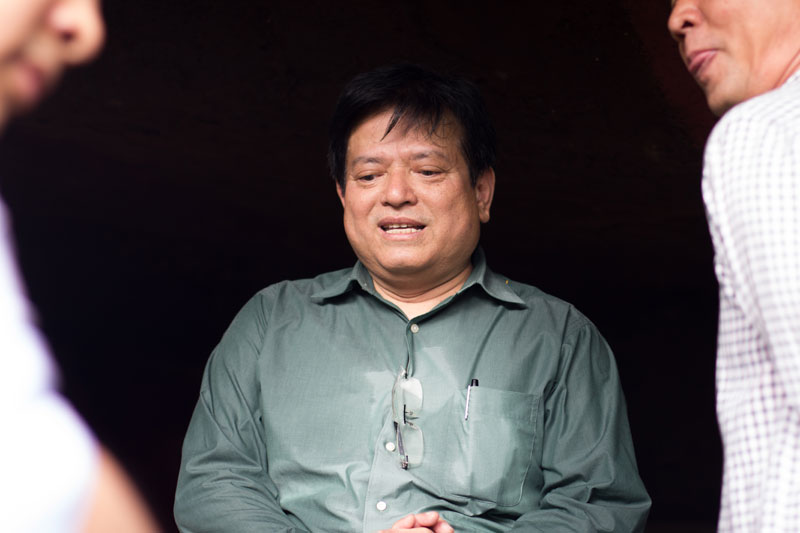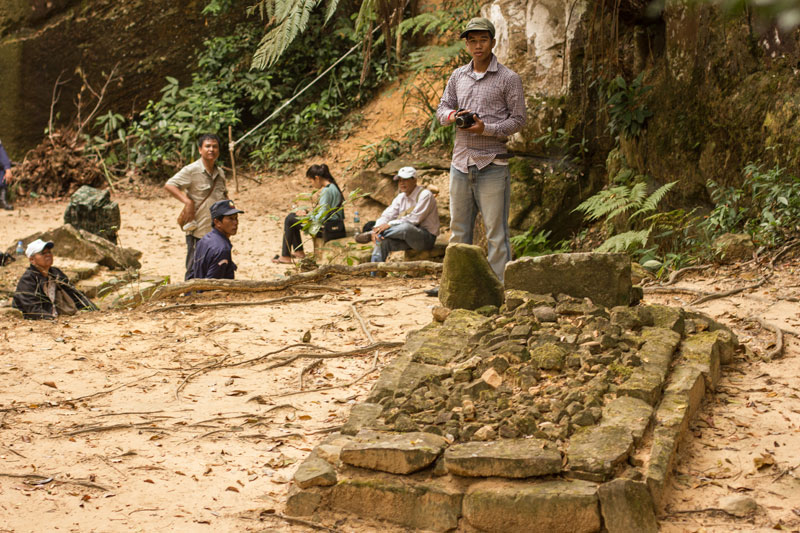BOKOR MOUNTAIN, Kampot province – Spurred on by social media rumors that Vietnamese tourists are flocking to this colonial-era retreat for elaborate, hidden ceremonies at the graves of their ancestors, CNRP lawmaker Yem Ponhearith on Thursday led about 50 officials here on a fact-finding trek.
Mr. Ponhearith, a spokesman for the opposition party who also chairs the National Assembly’s commission on religious affairs, culture and tourism, last month noted the eruption of posts online claiming the ceremonies deep in Bokor Mountain’s jungle are infringing on Cambodian culture.

He promised to inspect the area and report his findings to the government. At about 8 a.m. on Thursday, Mr. Ponhearith arrived at an opening in the jungle on the mountain’s north, after staying overnight at the $1-billion Sokha Hotel opened on Bokor in 2012.
With CNRP lawmakers including the 72-year-old Long Botta in tow, the difficulty of the four-hour trek appeared to come as a surprise to many in the group, who at times had to rappel down 60-degree gradients using rope crudely tied to trees.
If the opposition officials were hoping to observe Vietnamese tourists praying to their ancestors deep in the jungle, however, the hike was a disappointment.
A cave under a boulder on the mountain’s edge was the first site reached, but displayed no trace of Vietnamese pilgrims.
“They were here, but they are all gone now,” said Yun Phally, a monitor for local rights group Licadho who served as one of Mr. Ponhearith’s guides, upon the groups’ arrival.
Mr. Phally displayed images on his smartphone, which he said he took in December, of Vietnamese people praying inside the cave surrounded by metallic objects and framed photographs of Vietnamese Communist leader Ho Chi Minh.
“I think that has been manipulated by the authorities and the company, because the commission broadcasted [its planned trip] through the media, so they knew about it and removed [the objects] to hide the evidence,” Mr. Phally said.
“We are concerned this place would become their property if authorities still let them come more and more to worship, which they claim is for their ancestors who died here,” he said.

Mr. Ponhearith, climbing into the empty cave, told a group of reporters that he had discussed the alleged Vietnamese ceremonies with Culture Minister Phoeurng Sackona but felt he had to come to Bokor to see the situation for himself.
The CNRP lawmaker said he was happy that the ceremonial set-up pictured in Mr. Phally’s photographs had been removed, and said it was important that Bokor Mountain remain a place for tourists to observe Cambodian culture.
“The purpose of this trip was to find a resolution for the nation,” he said. “Every country attracts tourists, and they have to show their national identity and the culture of the nation, so preserving our national identity is most important.”
“From now on, there are no more [ceremonial materials] here, and we will manage this place for the national identity,” he said. “It is the freedom of people to practice their faith, but we must manage this place to show our identity.”
Speaking after Mr. Ponhearith, Svay Vuthy, the public relations director for the Sokha Hotel—which manages the entire mountain and is owned by ethnic Vietnamese businessman Sok Kong—confirmed that Vietnamese tourists often visit.
“Vietnamese have been coming here since before the company started development,” said Mr. Vuthy, who explained that nearby graves had been drawing tourists to the mountain for years before the hotel arrived.
“Some groups come in the morning and leave in the evening, and some groups stay overnight,” he said. “We do not ban them, because they are tourists visiting the mountain.”
Mr. Ponhearith’s group also trekked to another site featuring more of the graves on terraced levels of a space in the jungle enclosed by a number of fallen boulders, into which large red Chinese characters had been carved and painted.

Sith Vannak, the provincial coordinator for Licadho, said the site was also home to Vietnamese ceremonies last year, but noted that only dripped candle wax remained on Thursday.
“I came to this place and saw a statue, portraits of Ho Chi Minh, and lighted incense, and a place set up like it’s for them to stay…and fruits displayed on the rocks and graves,” he said of a visit in mid-December.
“We met about 20 Vietnamese. Some were cooking, some were meditating on the rock and some…were bathing,” he added. “It is rare for Khmers to come here because it is a hard place. We’ve only been aware of this for about two years.”
Others on the trip expressed fear that the large migration of civilian Vietnamese that led to Cambodia’s loss of what is now Southern Vietnam could be repeated in what remains of the country.
Sam Chakrya, a CNRP member of Kampot’s provincial council who joined Mr. Ponhearith’s troupe, said she believed the graves were created by Vietnamese people as a ruse to eventually claim a cultural connection to the land.
“We have seen before that they borrow something for five years and take it forever,” Ms. Chakrya said.
“In the future, they want Bokor Mountain to come under their ownership, so they are causing their new generation to believe their ancestors died here, and this is their evidence to show this is their land when they take the Cambodian land.”



